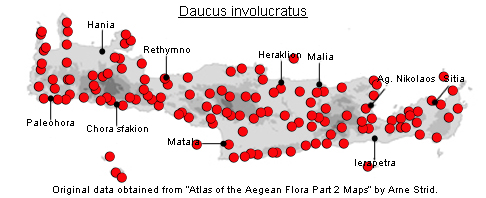SPECIES DESCRIPTION
DAUCUS INVOLUCRATUS
Family:- UMBELLIFERAE/Sect. DAUCUS
Common Names:- None
Synonyms:- None
Meaning:- Daucus (L) Latin name for carrot.
Involucratus (Gr) Surrounded with bracts, involucrate.
General description:- Annual.
Stems:- Up to 20 cm, usually several, ascending, branched from the base, sparsely
hispid or subglabrous.
Leaves:- 1- to 2-pinnate, the segments divided into oblong-lanceolate lobes.
Flowers:- Rays 3-4, short. Bracts usually longer than the rays, not deflexed,
divided into multiple lobes the divisions extending almost to the midrib (pinnatisect);
bracteoles entire. Petals less than 1 mm, white or purplish.
Fruit:- 2-5 mm; spines of the secondary ridges 3 times as long as the width of the
mericarp.
Key features:-
1) Spines on secondary ridges of mericarp dilated, confluent at the base or winged,
(1-)2-3 times as long as the width of the mericarp.
2) Rays 3-4; the petals less than 1 mm.
Habitat:- Coastal habitats, (sand dunes, gravelly shores, etc.), dry pastures, dry
open shrubby vegetation, open pinewood. 0-900(-1400) m.
Distribution:- E and S Greece and Aegean region SW Asia. Widespread and
common on Crete.
Flowering time:- Apr-July.
Photos by:- Fotis Samaritakis
FAMILY AND GENUS DESCRIPTIONS
UMBELLIFERAE
General description:- Herbs, rarely shrubs.
Leaves:- Alternate; lamina usually large and much-divided; petiole often inflated
and sheathing at base. Stipules absent.
The primary divisions of the leaves are referred to as segments and the ultimate
divisions, cut nearly or quite to the midrib, as lobes. The lobes may themselves
sometimes be deeply lobed. The leaves are never truly pinnate, but are described
as pinnate, for brevity, when the lamina is divided to the midrib.
Flowers:- Inflorescence usually a compound umbel. Flowers epigynous, small,
hermaphrodite or unisexual, the plant rarely dioecious. Sepals usually small or
absent; petals 5, usually more or less 3-lobed, the middle lobe inflexed; outer
petals sometimes much larger than inner (radiate); stamens 5; carpels (1-)2,
usually attached to a central axis (carpophore), from which the mericarps separate
at maturity; styles (1-)2, often with a thickened base (stylopodium); ovule 1 in each
loculus, pendent.
Descriptions of umbels refer to the terminal, or other well-developed umbel: lateral
umbels are often smaller, with fewer rays, and may be entirely male. Bracts are the
structures which subtend the primary branches (rays) of a compound umbel, and
bracteoles are those which subtend the partial umbel, or the whole of a simple
umbel. When the stylopodium is described, the description refers to the
stylopodium of a hermaphrodite flower.
Fruit:- Dry; pericarp membranous or exocarp variously indurated; endocarp rarely
woody. Mericarps usually joined by a narrow or wide commissure; each mericarp
more or less compressed laterally or dorsally, with 5 longitudinal veins, usually with
ridges over them, separated by valleculae or sometimes with 4 secondary ridges
alternating with the primary; resin canals (vittae) usually present between the
primary ridges and on the commissural face.
Descriptions of the ridges of the fruit refer to the primary ridges, unless otherwise
specified.
Ripe fruit is essential for the certain identification of some genera, though with a
little experience the characters of the ripe fruit can often be deduced from a careful
examination of unripe fruit or even the ovary.
DAUCUS
Leaves:- 2- to 3-pinnate.
Flowers:- Bracts several, usually pinnatisect. Sepals small or obsolete. Petals
white, yellowish or purplish, the outer often radiate; apex inflexed.
Fruit:- Ellipsoid to ovoid, cylindrical or somewhat compressed dorsally; primary
ridges thread-like (filiform), fringed with hairs (ciliate); secondary ridges with a
single row of spines.
Key features:-
1) Both mericarps similar.
2) Fruit with broad, or tubercle-based prickles arranged in 1-3 rows on the ridges.
3) At least some bracts 3-fid or pinnatisect.
Sect. DAUCUS
Leaves:- Leaf-lobes petiolulate.
Flowers:- Umbels pedunculate. Styles medium to long, erecto-patent.
